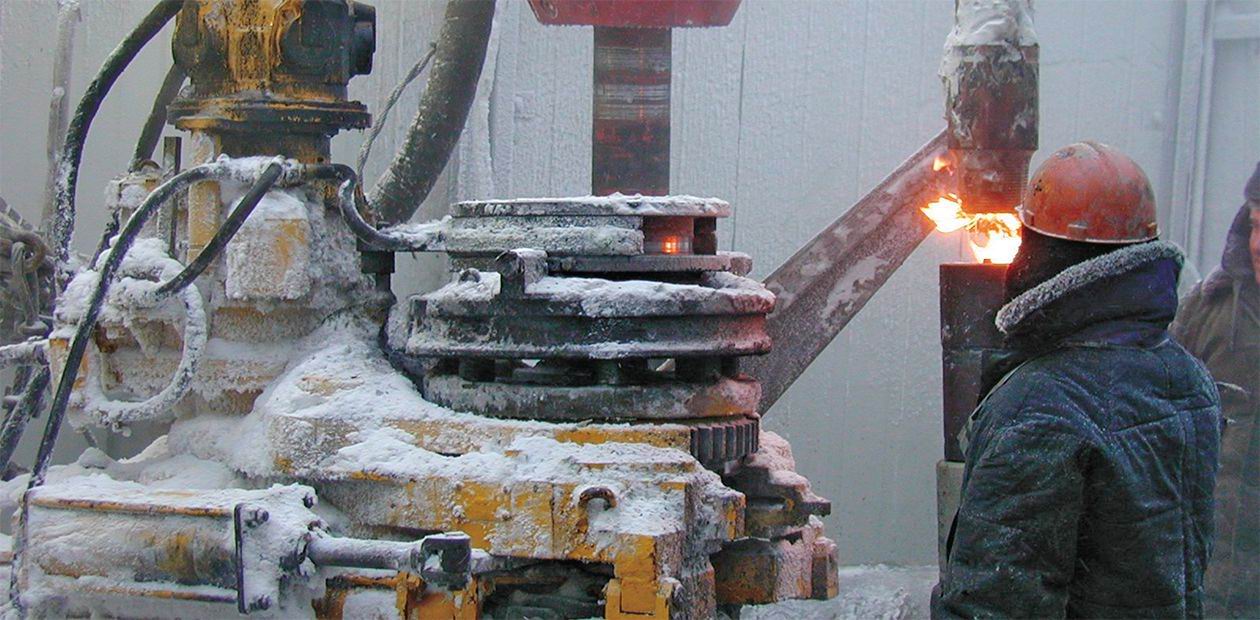Electromagnetic Logging*: Every Cloud Has a Silver Lining
Oil extraction is hard work. From the surface, people control the tubes and pumps submerged into a depth of several kilometers. Geophysical methods of ground research help oilmen in searching for optimal places for boring production wells. Specialists from the Siberian Branch of the Russian Academy of Sciences (SB RAS) have developed a method for interpreting electromagnetic logging data. This method not only ensures reliable evaluation of saturation of in-depth deposits with oil and gas, but also predicts the amounts of oil and gas that can be extracted
* The term used for logging in other languages (e.g. French and Russian) originates from the French word carotte (carrot) and means “boring wells for studying the Earth strata”
The oil and gas deposits available to our generation are located deep in the ground. Before starting industrial development of a hydrocarbon deposit, it is necessary to obtain some quantitative estimates of its total amount and concentration. These two basic parameters determine the possible profitability of production.
It is unreasonable to take blind samples at large depths; for this reason, researchers invented geophysical methods for determining the deposit boundaries and its productivity last century. One of the methods is based on the fact that electrical conductivity of hydrocarbons is lower than that of water. Based on electrical conductivity, it is also possible to distinguish gaseous hydrocarbons from liquid hydrocarbons (oil).
In nature, all these “fluids” impregnate the porous space of permeable layers (strata) of ground. Thus, by measuring their specific electrical resistance (SER), it is possible in principle to estimate the concentration and even approximate composition of hydrocarbons contained in these strata.
The sensitivity of electromagnetic methods allows measurements to be performed at a certain distance from the examined object, though not farther than 10 m away from it. Therefore, to study mineral deposits, it is necessary to place the measurement equipment into a depth of 2—3 km. This is done with the help of exploratory wells.
Permanent removal of bored-out rocks is necessary in the course of well boring. At the moment, water-based clay solutions are used for this purpose. The use of such a solution, however, is accompanied by certain adverse phenomena. Thus, a colloid solution of clay contacts the destroyed rocks on the way back and is subjected to partial stratification. In this case, the solution filtrate penetrates into the oil reservoir, and clay particles together with stratification products are deposited on the well wall, forming a cake.
The mud filtrate is weakly mineralized water (as compared with underground waters accompanying oil and gas). Since the electrical conductivity of a porous earth stratum strongly depends on the content of water and its mineralization, the electromagnetic properties of the medium are violated in the solution invasion zone. The direct use of the SER value, which has been changed by human interference, would lead to cardinal errors in estimating the content of hydrocarbons in the entire reservoir.
Nevertheless, the study of near-well invasion zone properties that vary during boring can be useful. Possessing valuable information about mud-rock interaction, one can model the related processes and solve “direct problems,” i.e. calculate the changes in these properties for different initial states of an oil and gas deposit.
Of practical importance, however, is solving the inverse problem: based on the geophysical data obtained for properties of reservoirs violated by boring, one can find the hydrocarbon saturation of undamaged reservoirs. To solve this problem, collaborative research was organized by the Lavrentyev Institute of Hydrodynamics SB RAS and the Laboratory of Electromagnetic Fields of the Institute of Oil and Gas Geology and Geophysics SB RAS (headed by Academician M. I. Epov).
As a result of this collaborative effort, a complex mathematical model with a block (modular) structure was developed. One of the main blocks of the model describes interrelated processes of the hydraulic flow of the mud in the tube space of the well, growth of the clay cake on the well wall, and filtration of immiscible fluids (water, oil, and gas) both in the invasion zone and in the unaffected part of the reservoir. Another important block models ionic exchange between the movable and rock-skeleton-bound water, because the reservoir SER is mainly affected by the content of water in the reservoir and its mineralization.
To couple the true electrical conductivity to the apparent (measured) SER, the mathematical model has a special computational module, which takes into account the specific features of propagation of electromagnetic waves in the rock saturated with electrolyte.
With the help of the model, interpretation of the sounding data reduces to a numerical solution of an inverse problem of geophysics: search for the initial conditions (initial saturation of the reservoir with oil and gas) that ensure the minimum root-mean-square deviation of the calculated SER from the value measured by the high-frequency inductive logging isoparametric sounding device.
It should be noted that solving inverse problems involves certain difficulties caused by the so-called instability in searching for a numerical solution. Therefore, it is important to constrict the search domain in advance.
For this purpose, the redistribution of immiscible phases of the fluid and the transition of salts between the waters in the filtrate penetration region were studied in detail. The analysis shows that all six possible mutual locations of oil, gas, and reservoir water displacement fronts can be encountered in practice. Mathematical methods helped to determine the domains corresponding to these cases in the diagram of the phase composition of the fluid almost in the entire range of the ratios of components.
It was also found that the order of their location depends exclusively on the initial ratio of the fluid phases in the porous space of the reservoir rather than on their chemical composition or physical properties. Therefore, data analysis helps to determine the order of phase displacement, which substantially constricts the domain of searching for the solution of the posed inverse problem and, correspondingly, reduces the time necessary for processing results of geophysical measurements and improves the prediction quality.
Sometimes there are pleasant exceptions, which confirm the wisdom of the proverb: “Every cloud has a silver lining.” Indeed, the boring technologies used distort the properties of the near-well invasion zone. The study of related processes, however, allowed Siberian mathematicians and geophysicists to develop a pioneering method of quantitative interpretation of electromagnetic sounding of rocks that form an oil or gas deposit.
The high-frequency inductive logging isoparametric sounding equipment and the method of data interpretation have already been tested on a deposit developed by LukOil (Kogalym, Russian Federation) and on a deposit in the Oklahoma state (USA). The results were considered excellent.
Moreover, this method turned out to be able not only to determine the degree of reservoir saturation with hydrocarbons, but also to calculate its permeability for oil and gas. It should be noted that existing technologies make it impossible to extract fossil hydrocarbons from a reservoir possessing weak filtration properties. Therefore, it is extremely important to obtain such information in due time in order to make an adequate decision on deposit development.
References
Antonov Yu. N. Isoparametric logging sounding (justification of high-frequency inductive logging isoparametric sounding // Geologiya Geofizika, 1980. No. 6. P. 81—91.
Pen’kovskii V. I. and Epov M. I. On the theory of processing of electromagnetic sounding data in a well //Dokl. Ross. Akad. Nauk, 2003. V. 390. No. 5. P. 685—687.
Pen’kovskii V. I. and Korsakova N. K. The new method of date interpretation of well electromagnetic sounding // IPSE, 2010. V. 18. No. 7. P. 983—995.






